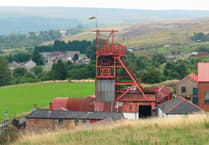A PROPOSED telecommunications mast in an area of outstanding beauty has been met with a barrage of objections and claims that the construction will not only be a blight on the landscape but also the cause of unknown wildlife damage in an ecologically sensitive area.
The construction is described by applicants, The Home Office and EE as a ‘17.5m telecommunications mast accommodating three antennas, two microwaves dishes, a pole mounted satellite dish, ancillary equipment cabinets and cabling, within a fenced compound, together with a new access area off the adjoining highway and a 3m wide crushed stone access track.’
But people living in the area have described it as a potential ‘monstrosity’ and utterly out of character with the pristine area.
Catharine Griffiths, whose family run the Grange Trekking Centre in nearby Capel-y-Ffin, told the Chronicle, ‘The area around this mast is inhabited by environmentally sensitive species such as linnets, waxwings, several species of bats and rare butterflies. They depend on microwave-free environments.’
Catharine’s mother, Mary Griffiths said, ‘I have lived in this valley all my life, I was born here and people come here specifically for the peace and quiet.
‘Not being in contact is a bonus, thank goodness for an unspoilt place. This valley is one of the few places left where you can feel close to nature. Once these places are gone they can never be restored.’
The proposed mast is on the site where ‘beat poet’, Allen Ginsberg was inspired to write his epic 1967 poem, ‘Wales Visitation.’
He spoke of the ‘earthly perfection’ of this corner of the Black Mountains while staying at Carney, the Welsh home of his friend and publisher Tom Maschler.
Carney is 150 metres from the proposed site of mast.
Writer, Bruce Chatwin, also spent five months at Carney writing his novel ‘On The Black Hill’, published in 1982.
Writer, Ian McEwan has submitted an impassioned objection to the Brecon Beacons Park Authority arguing that a more appropriate site must surely exist, “It is impossible to imagine how this proposed vertical of steel and concrete, which would dominate the head of so precious a valley, could fulfil the statutory aims of conserving and enhancing the natural beauty, wildlife and cultural heritage of the Park’.
Among the objectors, The Campaign for the Protection of Rural Wales, Brecon and Radnor Branch, highlights what they describe as the ‘Unacceptable impacts on landscape and cultural heritage contrary to the statutory purposes of the National Park.’
An internal Parks Authority memo from planning ecologist Nicky Davies reminds decision makes, ‘Biodiversity considerations must be taken into account in determining planning applications.
Planning permission should be refused if the proposals will result in adverse harm to wildlife that cannot be overcome by adequate mitigation and compensation measures.’
Powys County Highways have suggested a number of issues which might have a bearing on the outcome of the application and have asked the authority to postpone any decision for more investigations to take place.
A Highways spokesman stated, ‘There are a number of issues that need to be addressed before the application can be determined positively. I request that an extension of time be agreed until October 24 to allow for the application to be heard at the October 23 meeting.’
Many local residents acknowledge the need for progress in communications, however they feel a much less invasive site or a series of micro-sites attached to existing modern farm buildings ought to be sought out.
Elizabeth Gibbs of the Brecon Beacons Park Society, stated, ‘The proposed mast is sited just at the point where the small road up the valley leaves the enclosed land for the open mountain. It is used by walkers and riders as the road is one of the important routes to the main ridges of the Black Mountains.
‘While the mast may not be so evident from greater distances we feel that many people, having close views from these Rights of Way, would find it an unpleasant intrusion into this remote and peaceful landscape.’
Telecommunications firm, EE declined to comment stating, ‘The planning application for the new mast was submitted by the Home Office. As a result you’d need to speak to them for further information. The Chronicle also contacted the office of Brecon and Radnor MP, Chris Davies, for comment but received no response.
At the time the Chronicle went to Press no response had been received from the Home Office.
Elizabeth Gibbs said, ‘’While we accept that this mast may be important for the Government’s Emergency Services Mobile Communications Programme we cannot accept its proposed siting.
The application has so far attracted one statement of support, five neutral statements and 58 objections.





Comments
This article has no comments yet. Be the first to leave a comment.